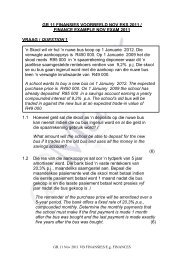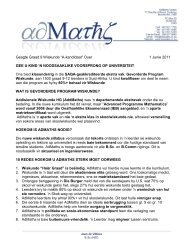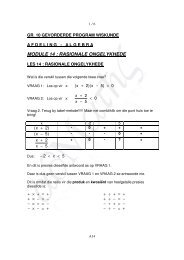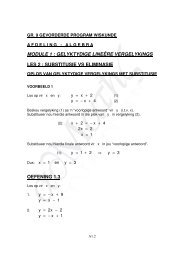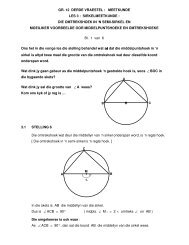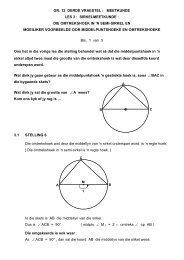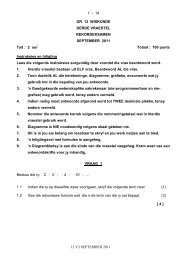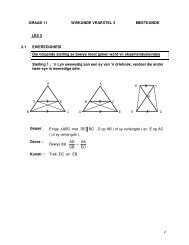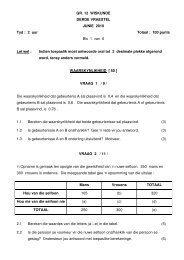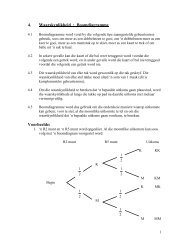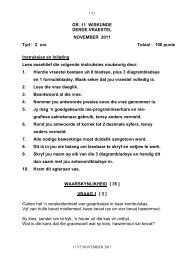1 GRADE 11 MATHEMATICS PAPER 3 GEOMETRY ... - AdMaths
1 GRADE 11 MATHEMATICS PAPER 3 GEOMETRY ... - AdMaths
1 GRADE 11 MATHEMATICS PAPER 3 GEOMETRY ... - AdMaths
Create successful ePaper yourself
Turn your PDF publications into a flip-book with our unique Google optimized e-Paper software.
<strong>GRADE</strong> <strong>11</strong> <strong>MATHEMATICS</strong> <strong>PAPER</strong> 3 <strong>GEOMETRY</strong><br />
LESSON 5<br />
5.1 SIMILARITY<br />
1 Polygons<br />
We have two rectangles ( all angles = 90° ) .<br />
The sides of the second rectangle are not a proportional enlargement of the<br />
⎛ 50 15 ⎞<br />
sides of the first rectangle. ⎜ ≠ ⎟<br />
⎝ 25 15 ⎠<br />
Their shape is not the same therefore they are not similar.<br />
Equal angles are not the only condition for quadrilaterals to be similar.<br />
In these two quadrilaterals the corresponding sides are proportional.<br />
⎛ 30 50 ⎞<br />
⎜ = ⎟<br />
⎝15<br />
25 ⎠<br />
25 mm<br />
25 mm<br />
15 mm<br />
15 mm<br />
50 mm<br />
50 mm<br />
However, the corresponding angles are not equal.<br />
Their shape is not the same therefore they are not similar.<br />
Proportionality of corresponding sides is not the only condition for<br />
quadrilaterals to be similar.<br />
15 mm<br />
30 mm<br />
1
25 mm<br />
15 mm<br />
40 mm<br />
In the two rectangles above the corresponding angles are equal.<br />
⎛ 40 24 8 ⎞<br />
The corresponding sides are proportional. ⎜ = = ⎟<br />
⎝ 25 15 5 ⎠<br />
The shapes are similar. The second rectangle is an enlargement of the first.<br />
These rectangles fulfil the conditions for two quadrilaterals to be similar.<br />
The same conditions are necessary for the similarity of pentagons, etc.<br />
Polygons are similar only if the are equiangular<br />
and their corresponding sides are in proportion.<br />
24 mm<br />
The two conditions for polygons to be similar are dependent on each other.<br />
2
<strong>GRADE</strong> <strong>11</strong> <strong>MATHEMATICS</strong> <strong>PAPER</strong> 3 <strong>GEOMETRY</strong><br />
2 Triangles<br />
Our main interest is in the conditions under which two triangles are similar.<br />
If two triangles are equiangular,<br />
then their corresponding sides are in<br />
proportion<br />
and the two triangles are therefore similar.<br />
If two triangles have proportional corresponding sides,<br />
then the triangles are equiangular<br />
and the triangles are therefore similar.<br />
It is interesting that the conditions of equiangularity and proportionality of<br />
corresponding sides in triangles are independent of each other.<br />
Congruent triangles are always similar.<br />
• The symbol for is similar to is<br />
• Do not confuse with ≡ , which is the symbol for is congruent to.<br />
• If ∆ ABC is similar to ∆ PQR , we write<br />
∆ ABC<br />
∆PQR<br />
• In naming similar triangles it is advisable to follow the same convention<br />
as that used for naming congruent triangle, i.e. the letters indicating<br />
corresponding angles should be written in the same order for all<br />
triangles.<br />
3
If in ∆ ABC and ∆ PQR<br />
Rˆ Â =<br />
Pˆ Bˆ =<br />
Qˆ Ĉ =<br />
Then ∆ ABC ∆RPQ<br />
It is now easy to write down the ratios which are equal.<br />
AB<br />
RP<br />
B C<br />
=<br />
BC<br />
PQ<br />
=<br />
AC<br />
RQ<br />
A<br />
Notice that AB , BC and AC ( the numerators ) are the sides of one triangle<br />
and RP , PQ and RQ ( the denominators ) are the sides of the other triangle.<br />
P<br />
Q R<br />
4
<strong>GRADE</strong> <strong>11</strong> <strong>MATHEMATICS</strong> <strong>PAPER</strong> 3 <strong>GEOMETRY</strong><br />
5.2 The proofs of the following theorems must be known for exam purposes<br />
Theorem 6 : When two triangles are equiangular, the corresponding sides<br />
are proportional.<br />
Given : ∆ ABC and ∆ PQR with Qˆ Bˆ P and ˆ Â = = .<br />
Reqd. :<br />
A<br />
B C<br />
Prove that<br />
PQ<br />
AB<br />
=<br />
QR<br />
BC<br />
=<br />
RP<br />
AC<br />
Constr. : Mark off points S and T on PQ and PR respectively<br />
such that PS = AB and PT = AC . Draw ST .<br />
Proof : ∆PST ≡ ∆ABC ( S ∠ S )<br />
Hence Qˆ Bˆ Sˆ 1 = = ( given )<br />
So that ST QR ( corresponding angles equal )<br />
Hence<br />
And<br />
PQ<br />
=<br />
PS<br />
PR<br />
PT<br />
PQ PR<br />
= ( PS = AB , PT = AC , construction )<br />
AB AC<br />
By marking points D and E on QP and QR respectively,<br />
so that QD = BA and QE = BC , it can be shown that<br />
PQ QR<br />
= .<br />
AB BC<br />
hence<br />
PQ<br />
AB<br />
=<br />
QR<br />
BC<br />
=<br />
RP<br />
AC<br />
P<br />
1<br />
S T<br />
Q R<br />
5
Conclusion<br />
Equiangular triangles are similar.<br />
A<br />
B C<br />
R . ˆ Q en Ĉ ˆ Bˆ P, ˆ Â = = =<br />
Hence, ∆ ABC ∆PQR<br />
Q R<br />
Theorem 7 : If the corresponding sides of two triangles are<br />
proportional, then the two triangles are equiangular.<br />
( converse of theorem 6 )<br />
B<br />
Given :<br />
A<br />
∆ ABC and ∆ PQR with<br />
AB<br />
PQ<br />
BC AC<br />
= = .<br />
QR PR<br />
Reqd. : Prove that 1 R1 ˆ<br />
Q en Ĉ ˆ Bˆ P, ˆ Â = = =<br />
C<br />
Constr. : Construct ∆ QSR on QR so that Bˆ Qˆ 2 = and Ĉ Rˆ 2 = ,<br />
with S and P on opposite sides of QR .<br />
Q<br />
P<br />
1<br />
1<br />
2 2<br />
S<br />
R<br />
P<br />
6
Proof :<br />
∆ ABC and ∆ SQR are equiangular ( construction )<br />
Hence<br />
AB<br />
=<br />
SQ<br />
BC<br />
QR<br />
Hence SQ = PQ .<br />
AB<br />
= ( given )<br />
PQ<br />
In the same way, SR = PR .<br />
Hence ∆SQR ≡ ∆PQR ( S S S )<br />
Hence Aˆ<br />
= Sˆ<br />
= Pˆ<br />
Bˆ<br />
= Qˆ<br />
2 = Qˆ<br />
1<br />
and also Cˆ<br />
= Rˆ<br />
2 = Rˆ<br />
1<br />
Conclusion If the corresponding sides of two triangles are proportional,<br />
then the triangles are similar.<br />
AB<br />
PQ<br />
=<br />
A<br />
B C<br />
BC<br />
QR<br />
=<br />
AC<br />
PR<br />
Hence ∆ ABC ∆PQR<br />
P<br />
Q R<br />
7
<strong>GRADE</strong> <strong>11</strong> <strong>MATHEMATICS</strong> <strong>PAPER</strong> 3 <strong>GEOMETRY</strong><br />
5.3 Useful hints for solving problems on similarity.<br />
1 Always write the names of the triangles so that the equal angles occur in the<br />
same order. Then it is not necessary to look at the figures to write down the<br />
proportionality.<br />
2 If two triangles, say ∆ AED and ∆ PRS , have been proved equiangular, the<br />
ratios of the corresponding sides can be written down immediately.<br />
∆ AED<br />
AE<br />
PR<br />
=<br />
ED<br />
RS<br />
∆PRS<br />
3 It is advisable to write down all three ratios and then select the two ratios<br />
which will give the required result.<br />
If in point 2 above we were asked to prove that AE.PS = PR.AD , we could use<br />
the first and third ratios and by cross-multiplication obtain the required result.<br />
4 If two triangles are to be proved equiangular, it is only necessary to show that<br />
two angles of the one triangle are equal to the two corresponding angles of the<br />
other triangle. Often a common angle can be found.<br />
5 Make separate sketches of the two triangles to be proved equiangular and<br />
mark off the equal angles. ( This is especially useful when many facts are<br />
given. )<br />
Useful hints continues ….<br />
=<br />
AD<br />
PS<br />
8
<strong>GRADE</strong> <strong>11</strong> <strong>MATHEMATICS</strong> <strong>PAPER</strong> 3 <strong>GEOMETRY</strong><br />
6 If we have to prove the product of two line segments equal to the product of<br />
two other line segments, the implication is that we have to prove two triangles<br />
equiangular, and hence similar.<br />
It is often difficult to recognise the two triangles.<br />
We proceed as follows :<br />
Write down the two equal products as a proportion.<br />
We use an example to illustrate this.<br />
B<br />
Reqd. : Prove that BQ.RP = AP.RQ .<br />
Analysing the problem<br />
Two proportionals equivalent to BQ.RP = AP.RQ are<br />
A<br />
BQ AP BQ RQ<br />
= and =<br />
RQ RP AP RP<br />
In the second proportional (but not in the first)<br />
the numerators are sides of the first triangle and the denominators are<br />
sides of the second triangle.<br />
We have therefore to prove that ∆ BQR and ∆ APR are equiangular.<br />
7 BD 2 = BD.BD<br />
If the square of a line segment (say BD 2 ) is equal to the product of two other<br />
line segments (say AD.DC), then BD is a common side of the two triangles<br />
which have to be proved similar.<br />
B<br />
R<br />
Q<br />
A<br />
P<br />
D<br />
C<br />
C<br />
9
5.4 EXAMPLES<br />
Example 1<br />
If we have to prove that BD 2 = AD.DC, we must prove ∆ ABD similar to<br />
∆ BCD ( BD is the common side ) .<br />
Name the similar triangles in the following figures and calculate the values of<br />
c m<br />
a , b , x , y , and .<br />
d n<br />
a) b)<br />
c) d)<br />
L<br />
Solution<br />
A<br />
24<br />
B<br />
a) ∆ AEB ∆DEC ( Â = alternate Dˆ and Bˆ = alternate Ĉ )<br />
Hence<br />
18<br />
E<br />
d<br />
15 30<br />
K<br />
AE<br />
DE<br />
18<br />
30<br />
=<br />
=<br />
a<br />
c<br />
N<br />
EB<br />
EC<br />
15<br />
a<br />
=<br />
C<br />
D<br />
=<br />
b<br />
7,5 P 17,5 S<br />
M<br />
m<br />
M<br />
n<br />
AB<br />
DC<br />
24<br />
b<br />
Hence 18a = 15 × 30 and 18b = 30 × 24<br />
a = 25 b = 40<br />
16<br />
Q<br />
S<br />
24<br />
P<br />
36<br />
x<br />
P<br />
30<br />
21<br />
R<br />
T<br />
y<br />
32<br />
R<br />
T<br />
10
)<br />
∆ PST ∆PQR ( PST ˆ = corresponding Qˆ and Pˆ is common )<br />
Hence<br />
PS<br />
PQ<br />
24<br />
40<br />
=<br />
ST<br />
QR<br />
=<br />
PT<br />
PR<br />
36 30<br />
= = ( cancel where possible )<br />
x 30 + y<br />
Hence 3x = 5 × 36 and 3(30 + y) = 5 × 30<br />
x = 60 y = 20<br />
c) ∆ MPN ∆MLK ( Mˆ is common, NPM ˆ = corresponding Lˆ )<br />
Thus<br />
MP<br />
ML<br />
=<br />
17,5<br />
=<br />
25<br />
c<br />
=<br />
d<br />
PN<br />
LK<br />
c<br />
d<br />
7<br />
10<br />
=<br />
MN<br />
MK<br />
d) ∆ SMP ∆STR ( Sˆ is common, SMP ˆ = corresponding Tˆ )<br />
2.1<br />
Thus<br />
Thus<br />
SM<br />
=<br />
ST<br />
MP<br />
TR<br />
m<br />
=<br />
m + n<br />
21<br />
32<br />
32m = 21(m + n)<br />
32m = 21m + 21n<br />
<strong>11</strong>m = 21n<br />
m<br />
=<br />
n<br />
21<br />
<strong>11</strong><br />
Example 2<br />
In ∆ ACE , FC ˆ BK A ˆ A = and BF CE and ACˆ<br />
K = AFˆ<br />
B .<br />
Proof that :<br />
AB<br />
=<br />
AF<br />
AK<br />
AC<br />
<strong>11</strong>
2.2<br />
Solution<br />
AC AK.AE<br />
2 =<br />
2.1 In ∆ ABK and ∆ AFC<br />
1. Â is common<br />
2. FC ˆ BK A ˆ A = ( given )<br />
∴ ∆ ABK ∆AFC ( ∠ ∠ ∠ )<br />
∴<br />
AB<br />
=<br />
AF<br />
AK<br />
AC<br />
2.2 In ∆ ACK and ∆ ACE<br />
1. Â is common<br />
2. FB ˆ A ĈK<br />
= A ( given )<br />
= Ê ( corresponding, BF CE )<br />
∴ ∆ ACK ∆AEC ( ∠ ∠ ∠ )<br />
∴<br />
AC<br />
=<br />
AE<br />
E<br />
C<br />
AK<br />
AC<br />
∴ AC AK.AE<br />
2 =<br />
K<br />
F<br />
B<br />
A<br />
12
5.5<br />
Exercise 5<br />
1<br />
2<br />
3<br />
In ∆ PST , TS ⊥ PS en RQ ⊥ PT .<br />
Prove :<br />
1.1 ∆ PRQ ||| ∆ PST<br />
1.2 RQ : PQ = ST : PT<br />
1.3 PR . PT = PQ . PS<br />
In the diagram, PA ║ BC and B 1<br />
∧<br />
Prove that :<br />
2.1 ∆ PAB ||| ∆ ABC<br />
2.2 PA : AB = PB : AC<br />
2.3 AB² = PA . BC<br />
Q<br />
P<br />
= ∧<br />
C .<br />
PQRS is a parallelogram and all the lines are straight lines.<br />
Prove that :<br />
3.1 ∆ TVQ ||| ∆ PVS<br />
PV QV<br />
3.2 =<br />
VU VS<br />
3.3 PV² = TV .VU<br />
P<br />
P<br />
V<br />
R<br />
1 2<br />
B C<br />
1<br />
R<br />
U<br />
2<br />
T<br />
1<br />
2<br />
2<br />
1 1<br />
Q<br />
S<br />
A<br />
T<br />
S<br />
13
4<br />
In the figure, BD ⊥ AC and AB ⊥ BC .<br />
 = 60º .<br />
If AB = 2 units and DC = 3 units,<br />
determine the lengths of AD and BC .<br />
Copyright Mr V Page 14 12/07/2010<br />
A<br />
60°<br />
D<br />
B C<br />
14




